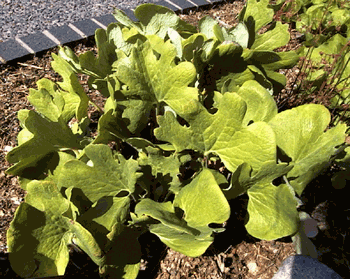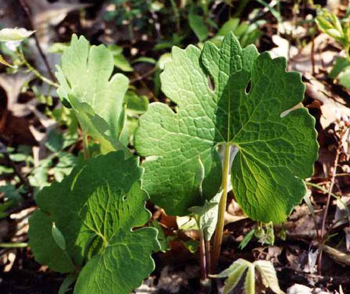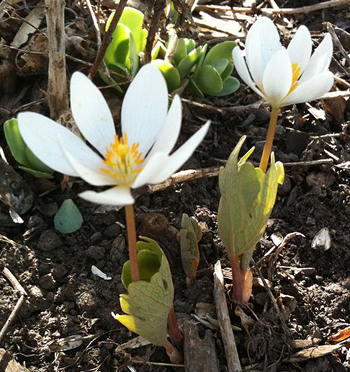Contents:
Common Names | Parts Usually Used | Plant(s) & Culture | Where Found | Medicinal Properties | Biochemical Information
Legends, Myths and Stories | Uses | Formulas or Dosages | How Sold | Warning | Resource Links | Bibliography
Scientific Names

- Sanguinaria canadensis L.
- Papaveraceae
- Poppy family
Common Names
- Indian paint
- Indian plant
- Indian red paint
- Pauson
- Red paint root
- Red puccoon
- Red root
- Sanguinaria
- Tetterwort
Parts Usually Used
Rootstock collected early in the spring, carefully dried, then ground into powder.
Back to Top

Description of Plant(s) and Culture
Bloodroot is a small perennial plant, about
May be propagated by seed or division.
Back to Top
Where Found
Found in shaded, rich soils in the northeastern states of the U.S.
Back to Top
Medicinal Properties
Expectorant, alterative, stimulant, diuretic, febrifuge, sedative, antibacterial, emmenagogue, tonic, emetic in larger doses. An overdose can be fatal.
Back to Top
Biochemical Information
Alkaloids including whelidonine, berberine, chelerythrine, sanguinarine
Back to Top

Legends, Myths and Stories
Bloodroot was used by the American Indians as a body paint and as a dye. A bachelor of the Ponca tribe would rub a piece of the root as a love charm on the palm of his hand, then scheme to shake hands with the woman he desired to marry. After shaking hands, the girl would be found willing to marry him in
One Indian folk medicine guide recommended a tincture made by filling a pint bottle half-full with finely mashed root and adding equal parts of alcohol and wart until full. The recommended dosage ranged from
A recommended ointment was made by mixing an ounce of the powdered root in
Back to Top
Uses
Internally: expectorant for acute and chronic respiratory tract affections, sinus congestion, stimulates the digestion, laryngitis, sore throat, asthma with cold thick phlegm, and croup. Most effective for pneumonia are
Externally: The tincture is directly applied externally for the treatment of fungus, eczema, cancers, tumors, and other skin disorders . It is a good remedy for athlete’s foot and rashes. An ointment of bloodroot alone or in combination with other herbs is directly applied to venereal sores, tinea capitis, eczema, ringworm, scabies, and warts.
Can be used for the following ailments: adenoid infections, nasal polyps, syphilitic troubles, piles (use strong tea as an enema), typhoid fever, catarrh, scarlatina, jaundice, dyspepsia, whooping cough and rheumatism.
Small doses stimulate the digestive organs and heart. Large doses act as a sedative and narcotic. When the condition is not easily overcome, combine with equal parts of goldenseal.
Experimentally, the alkaloid sanguinarine has shown antiseptic, anesthetic, and anticancer activity.
Back to Top
Formulas or Dosages
As a stimulant, expectorant, or alterative use;
drops.
In a dose of
The drug is usually administered in several-drop dosages of a tincture.
Back to Top
How Sold
Tincture, powdered root Today, components of the root are used in minute amounts in commercial toothpastes and mouthwashes to fight plaque.
Back to Top
Warning
Bloodroot is a powerful herb. Some reports of nibbling the root has caused tunnel vision. Do Not Ingest.
Do not use without medical supervision. An overdose can be fatal.
Back to Top
Resource Links
LiveStrong.com: Bloodroot Therapy
LiveStrong.com: Bloodroot Paste for Moles
LiveStrong.com: Bloodroot Application for Moles
Memorial Sloan-Kettering Cancer Center: Bloodroot
Bibliography
![]() Back to Eden
Back to Eden, by Jethro Kloss; Back to Eden Publishing Co., Loma Linda, CA 92354, Original copyright 1939, revised edition 1994
![]() The Complete Medicinal Herbal
The Complete Medicinal Herbal, by Penelope Ody, Dorling Kindersley, Inc, 232 Madison Avenue, New York, NY 10016, First American Edition, copyright 1993
![]() Eastern/Central Medicinal Plants
Eastern/Central Medicinal Plants, by Steven Foster and James A. Duke., Houghton Mifflin Company, 215 Park Avenue South, New York, NY 10000
![]() The Herb Book
The Herb Book, by John Lust, Bantam Books, 666 Fifth Avenue, New York, NY. copyright 1974.
![]() Planetary Herbology
Planetary Herbology, by Michael Tierra, C.A., N.D., O.M.D., Lotus Press, PO Box 325, Twin Lakes. WI 53181., Copyright 1988, published 1992
 How Indians Use Wild Plants for Food, Medicine & Crafts
How Indians Use Wild Plants for Food, Medicine & Crafts, by Frances Densmore, Dover Publications, Inc., 180 Varick Street, New York, NY 10014, first printed by the United States Government Printing Office, Washington, in 1928, this Dover edition 1974
![]() American Folk Medicine
American Folk Medicine, by Clarence Meyer, Meyerbooks, publisher, PO Box 427, Glenwood, Illinois 60425, 1973
![]() Indian Herbalogy of North America
Indian Herbalogy of North America, by Alma R. Hutchens, Shambala Publications, Inc., Horticultural Hall, 300 Massachusetts Avenue, Boston, Massachusetts 02115, 1973
 The Rodale Herb Book: How to Use, Grow, and Buy Nature’s Miracle Plants (An Organic gardening and farming book)
The Rodale Herb Book: How to Use, Grow, and Buy Nature’s Miracle Plants (An Organic gardening and farming book), edited by William H. Hylton, Rodale Press, Inc. Emmaus, PA, 18049., 1974
![]() Webster’s New World Dictionary
Webster’s New World Dictionary, Third College Edition, Victoria Neufeldt, Editor in Chief, New World Dictionaries: A Division of Simon & Schuster, Inc., 15 Columbus Circle, New York, NY 10023
